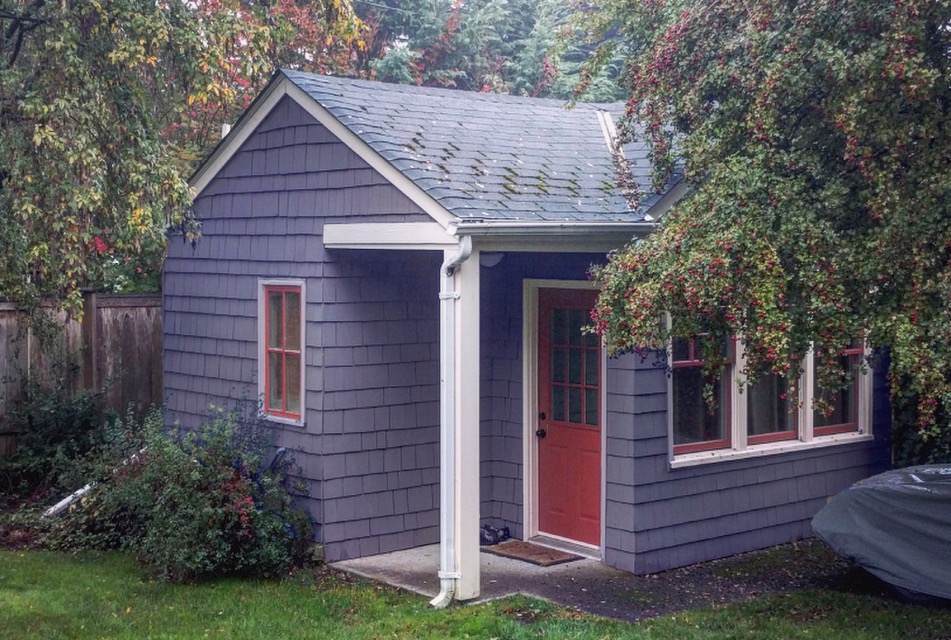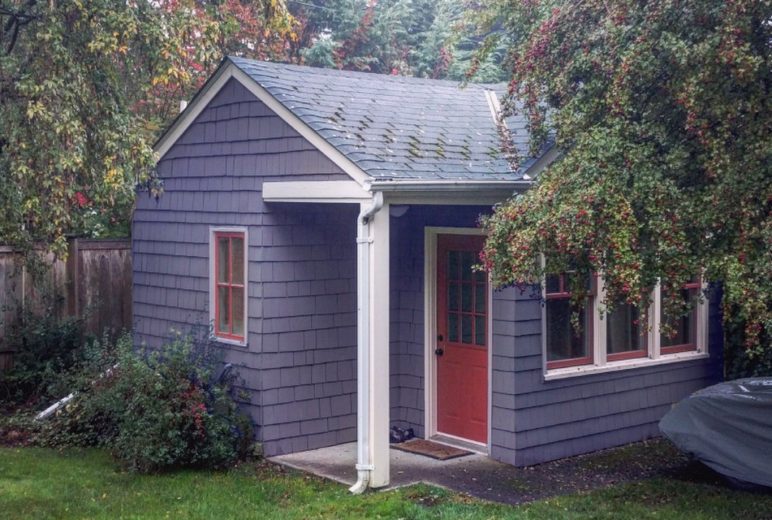Tacoma has joined the growing list of Cascadian cities taking action to welcome more in-law apartments and backyard cottages into their residential neighborhoods. On Tuesday, the Tacoma city council adopted a liberalized set of rules for accessory dwelling units (ADUs). Tacoma got a lot right with its ADU reform, but there’s still room for improvement.
Washington state law requires cities with populations above 20,000 to permit ADUs, but most impose all manner of restrictions that make it hard for homeowners to actually build them. As the housing squeeze tightens, some cities are revising their ADU rules to spur production. The Washington cities of Bellingham and Vancouver saw ADU permit applications jump after they loosened regulations, demonstrating demand held back by restrictive rules. This year the state legislature is considering a bill that would require Washington cities to remove key barriers to ADUs.
ADUs are modest, green, relatively affordable homes that open up amenity-rich neighborhoods to people who can’t afford the steep admission price of a stand-alone house on a large lot. They can flexibly serve a wide variety housing needs, from seniors aging in place, to multigenerational households, to young families. To unleash these benefits, the first step cities can take is to get their counterproductive regulations out of the way.
Here’s a rundown of Tacoma’s new ADU rules, with elaboration to follow:
The good
- Legalizes detached accessory dwelling units (DADUs)—that is, backyard cottages
- Retains the existing exemption from off-street parking requirements
- Removes the requirement for the owner to live on the property
- Removes minimum lot size requirements
- Retains the five-foot rear setback and allows zero setback for DADUs on alleys
- Waives setback requirements for existing structures being converted to ADUs
- Does not count ADUs against housing unit density limits
- Replaces the previous occupancy limit of four per ADU with the building code formula of home square footage divided by 200 (five occupants allowed in 1,000 sq.ft, for example)
- Does not impose an occupancy limit specific to unrelated residents
- Retains the exemption of ADUs from impact fees
- Removes the requirement for an extra ADU “Land Use Permit”
- Extends “amnesty program” that gives owners of unpermitted ADUs until December 31, 2020 to apply for an ADU permit under relaxed regulations
The good, but could go further
- Raises the allowed ADU size to 85 percent of the main house size
- Allows a height a increase from the standard 18-foot limit to 20 feet for DADUs over a garage, that meet the Built Green 4-Star standard, or that are converted from an existing structure.
The bad
- Retains limit of one ADU per lot
- Requires the owner to live on site if the ADU is used as a short term rental
- Retains requirement for the “ADU design to complement the main house”
Tacoma’s ADU reform got a lot right
The two most impactful moves Tacoma made are the legalization of backyard cottages and the removal of owner occupancy requirements. Washington law legalized ADUs but didn’t mandate an allowance for detached ADUs. Five of 44 Washington cities we surveyed still prohibit DADUs.
Requiring the homeowner to live on site if there’s an ADU on the property precludes ADUs in the one out of four Tacoma houses that are rentals. Also, an owner occupancy requirement discriminates against renters and is probably illegal. Cities have no such requirement for owners who rent out their detached houses.
Tacoma wisely retained its previous exemptions for ADUs from off-street parking quotas and impact fees (Tacoma doesn’t charge impact fees on any housing). The city also loosened key rules on lot size, setbacks, and occupancy.
Ways to make Tacoma’s ADU reform even better
Permit two ADUs per lot: This allowance would grant homeowners more flexibility, further city goals to increase housing options, and cause little additional change to neighborhoods. Seattle’s recent ADU environmental study estimated that an allowance for two ADUs per lot would yield just a two percent increase of homes in single-family zones over 10 years.
Raise the ADU size maximum: Tacoma restricts ADU size to 1,000 square feet, or 15 percent of the lot size, or 85 percent of the main house size, whichever is smallest. For a standard 5,000 square foot lot, that sets the maximum ADU size to 750 square feet—a relatively modest size for an ADU. Coupling the ADU size cap to lot or house size unfairly restricts the opportunities for owners of small houses or small lots. If an ADU meets all other physical requirements, why should it have to be smaller just because the lot or the main house is smaller? A simpler, more fair solution would be to get rid of the lot and house size-based limits but retain the blanket 1,000 square foot cap. Seattle currently allows 1,000 square feet for ADUs that are part of the main house, and has proposed raising the limit for DADUs to 1,000 square feet.
Raise the height limit: Tacoma’s 18-foot height limit precludes two-story DADUs. To allow them, the city could raise the cap to 20 feet or more. For DADUs that meet energy efficiency standards, the rules should allow at least 22 feet to leave room for design flexibility and thicker roof insulation. Vancouver, Washington’s new ADU code allows a height of 25 feet.
Do not restrict short term rental use with owner occupancy requirements: Financing is a big hurdle for most homeowners and one of the biggest barriers to ADU construction. Limiting the flexibility of income sources makes a new ADU a more risky investment, one that homeowners will be less likely to pursue. Also, cities don’t ban owners from putting their houses on the short term rental market while not living in them.
Get rid of requirements for the ADU design to match the main house: Such requirements are subjective, difficult to define, and introduce cost and uncertainty into ADU projects. Some innovative ADU construction types cannot be made to look like an old house. Modular cottages are in the works from several companies, and they’re likely to be far cheaper than custom-made ones. But modular cottages will not match most housing stock. What’s more, some houses are ugly. Do cities really want to require ugly ADUs to mimic them? Why not let the owner decide, just as they can with the main house?
What it took to get ADU reform done
Tacoma first allowed backyard cottages in December 2015 through its Residential Infill Pilot Program. To address displacement concerns and housing needs, the City Council passed a resolution in December 2017 directing the Planning Commission to increase the number of DADUs allowed in the Pilot Program. The Planning Commission instead recommended in October 2018 that the city allow DADUs outright, which the Council’s Infrastructure, Planning and Sustainability Committee reviewed in late 2018 and early 2019. The City Council held a study session and a public hearing in February and conducted final deliberations in March.











Paul T CONTE
Pray tell, what makes a second dwelling with no owner-occupancy an “in-law flat”?
Let’s show a little honesty for a change.
If you have a good argument for upzoning single-family zones to two-family zones over the objections of homeowners who bought their homes when the zoning was single-family … let’s hear it.
But blog posts on this site consistently misrepresent the nature of what they’re promoting, as well as the consequent impacts, good and bad.
It’s a shame to see so-called “progressives” following a script out of Trump’s playbook.
Dan Bertolet
We link to thousands of words of explanation in the article. After reading all that, if you have any specific examples of what you think we’ve misrepresented… let’s hear it!
simon
Gosh Paul, the folks that lived in the area you now live in thought the same thing you do about up-zoning. What do you think the Puyallup Indians thought about up-zoning?
If you supported the Growth Management Act, better get used to continual up-zoning…
Paul T CONTE
But dishonesty is OK with you, Mark?
Paul T CONTE
@simon
Do you actually know anything about the area I live in?
Do you actually know anything about my many years of work to further TOD and affordable housing?
Paul T CONTE
Oh c’mon. It’s in the first line of my comment. Why don’t you start by explaining how “in-law apartments” as the headline of this article is honest?
Mark Codispoti
The concluding line with divisive terms inserted made, for me, this comment entirely irrelevant. Inflaming not how things get done.
Laura
Greedy much? Over the objections of homeowners who bought into a single family housing neighborhood you aren’t happy with one ADU on the lot you want two? And they can be almost the size of the existing dwelling? And you think it’s unreasonable to have architectural similarity and parking? No thank you! If I wanted to live on the ant hill they call Capitol Hill and look at cheap, crammed in, ugly structures, I would have moved there. I’m happy you made the choice to stay in Seattle and ride your bike everywhere. Just don’t force your agenda and lifestyle on people who don’t want it here in Tacoma. Infill the vacant lots around the city, including downtown and Dome District before altering our quaint neighborhoods and small business districts.
Donde Groovily
Laura, just to be clear –
This new law ALLOWS ADUs, it doesn’t require them. Your preferred policy, it appears, is to BAN ADUs.
You are the one who wants to force your lifestyle on everyone else.
Paul T CONTE
“This new law ALLOWS ADUs, it doesn’t require them.”
More dishonesty. The issue is absolutely not one of “choice” for all residents of a neighborhood. Some/many residents would “choose” to not to have their neighborhood upzoned to allow two dwellings on an adjacent lot. This approach to upzoning is plain-and-simple about forcing and upzone.
Personally, I support ADUs and other forms of lot development with multiple dwellings, but changes such as this should come from the bottom-up.
What I vehemently object to is the dishonesty so frequently used by the zealots who think “we know best.”
Laura
Donde, explain to me exactly how I’m forcing my lifestyle and other people when I bought into a lifestyle that had already been here for a hundred years. The picture you posted above of the mother-in-law house we all know isn’t going to be the typical DADU. How about I start posting pictures of what they’re really going to look like? We have plenty of examples creeping in from 6th Avenue. Your picture of the Craftsman cottage in the idyllic backyard isn’t reality.
John
The cottage shown in the image isn’t in Tacoma, its a internet shot
Laura
Whatever and where ever it is, it doesn’t represent what is really going on.
Dan Bertolet
I got the image from a City of Tacoma document and Tacoma city staff confirmed that the cottage is located in Tacoma.
Tom Emerson
I think Paul Conte is referring to the use of “in-law apartments” in the article’s title, which appears to be all he actually read. He interjects a political reference into his comment when the article doesn’t speak to politics at all, leading me to believe he was predisposed to be against ADUs and probably didn’t bother to actually read the article.
I do have a question about what appears to be a laudably quick trigger on review of an ordinance that only went into effect in 2015. Was something built into the initial approval? Is development proceeding quickly enough in Takoma that data is available in such short order? Is there a longer history of ADUs in Tacoma that figures into the thinking?
Paul T CONTE
Of course, you neither know whether I read the entire article (I did) or whether I oppose ADUs (I don’t).
john
Its funny how libertarian support developers and free market economics models but call themselves progresses. In their eyes developers are seen as good and they love to loosening regulation when it doesn’t impact them personally. Pushing their life style on others is ok but respecting others is not.
This move by Tacoma will impact home owner and renters but not in the positive way this article tries to spin this topic. A few ADU’s that are too expensive for most will not aid in the housing crisis but was pushed by the Development class and speculators to make even more off the residence of this City without paying their far share.
This article is full of holes only that only that the followers of this trend in housing will not even notice. How about the fact that the cottage you show is about a third the size of the ADU’s approved, was built in keeping with its neighborhood and oh by the way its an internet images that not in Tacoma.
Congratulation on the win, I hope your still around to fix the problems when they arise.
Laura
Thank you John. The person who wrote this article, judging from their Twitter account, doesn’t even live here.
Eben Fodor
The Sightline Institute seems to be doing some strident advocacy for upzoning single family neighborhoods. This is done without much or any acknowledgement for the tradeoffs and complexities. Such a myopic viewpoint in so many articles seems to indicate that alot of developers are punching the “donate” button on this site.
I had really given up on this group until I saw an excellent presentation by a staffer on the campaign finance issue. So Sightline is still doing some good work, just not on the housing issue.
Deb
How much do these ADU’s cost? I was under the impression that they don’t cost as much as a typical 1-bed appartment.